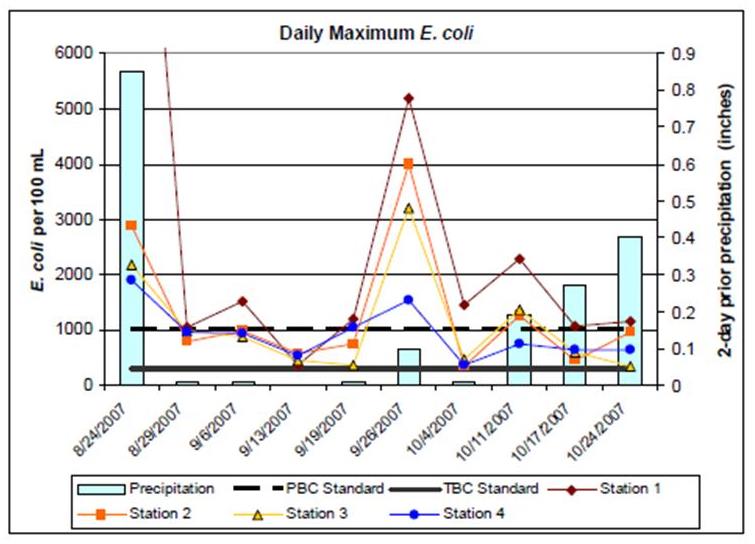The Huron is southeast Michigan’s only “Country-Scenic River,” yet it too faces pollution challenges. Bacterial contamination, especially following rain storms, remains a human health concern for some parts of the watershed.
What is bacterial contamination?
There are many forms of harmful bacteria that can contaminate a watershed. However, only one form of bacteria, E. coli, is measured as an indicator of the presence of bacteria in general.
 Coliforms are a group of bacteria that includes a smaller group known as fecal coliforms, which are found in the digestive tract of warm-blooded animals. Their presence in freshwater ecosystems indicates that pollution may have occurred and that other harmful microorganisms may be present. A species of fecal coliform known as Escherichia coli, or E. coli, is analyzed to test for contamination, and its presence may predict the presence of multiple harmful microorganisms.
Coliforms are a group of bacteria that includes a smaller group known as fecal coliforms, which are found in the digestive tract of warm-blooded animals. Their presence in freshwater ecosystems indicates that pollution may have occurred and that other harmful microorganisms may be present. A species of fecal coliform known as Escherichia coli, or E. coli, is analyzed to test for contamination, and its presence may predict the presence of multiple harmful microorganisms.
While most strains of E. coli are not dangerous, some strains and associated microorganisms, when taken into the body, can cause severe sickness. For more, see “Why do bacteria levels matter?”
It is important to note, however, that an elevated level of E. coli in one part of a body of water does not mean that the entire body is contaminated. One key area where HRWC is working to define the scope of the bacteria contamination is Honey Creek. A remediation plan has also been developed for the Huron River between Argo and Geddes Pond impoundments.
How are bacteria levels measured?
E. coli levels are monitored at specific locations in the watershed on a regular basis. All designated swimming beaches across the state are required to test waters for bacteria levels on a daily basis during the swimming season. Information on swimming beaches can be found at the Michigan Department of Environmental Quality’s (MDEQ) BeachGuard website. In addition, the MDEQ samples a range of randomly selected sites once every five years to identify potential problem areas in the watershed. Finally, HRWC employs both volunteers and staff to routinely sample streams for E. coli levels at around 20 sites in the watershed, both in the main stem and in the tributaries, from April through September. Water samples are collected and sent to a lab, where lab staff determine a count of E. coli colonies.
If a persistent elevated levels of E. coli emerge through general sampling, Bacterial Source Tracking (BST) can be used to help determine the species of E. coli present and thereby narrow the scope of possible sources of the contaminant. BST uses genetic identification techniques and is more expensive than general monitoring, so it is only used after a potential problem has been identified.
Why do bacteria levels matter?
Where does bacteria come from and what can be done?
image source: graur razvan ionut



